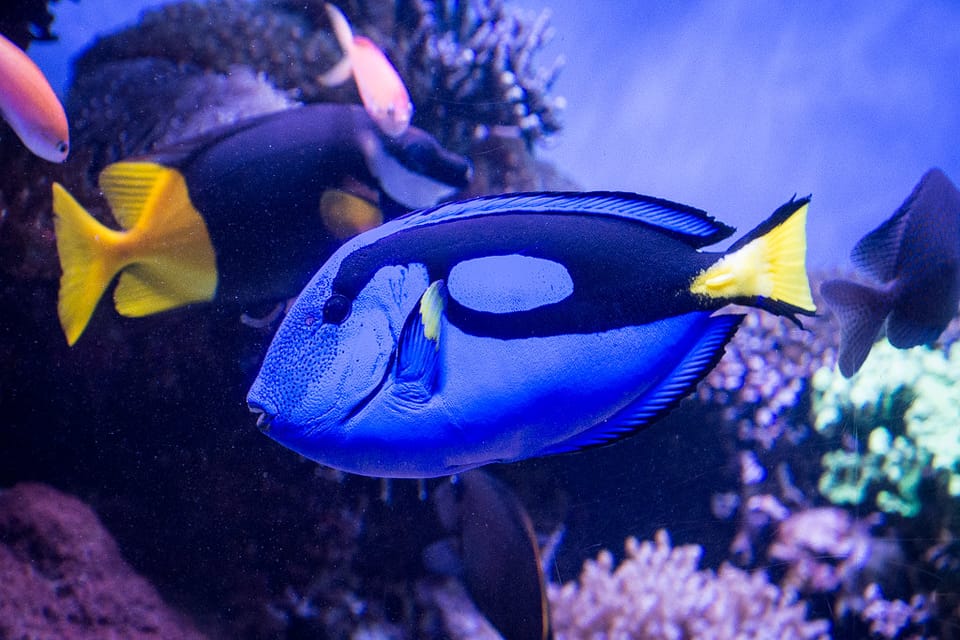Exploring the Senses: Sight

All animals take advantage of their senses to explore the world around them, but it’s a mistake to assume that other creatures have the same sensory options or that they use them in the same way as humans. Vision is extremely important to humans and we excel in taking in all the details in full technicolour. But this doesn’t apply to animals in general. As Ed Yong points out in An Immense World, “Eyes didn’t evolve from poor to perfect. They evolved from performing a few simple tasks perfectly to performing many complex tasks excellently.” [1]
Animals see what they need to see. A zebra looks much like a donkey to a lion as its vision is below the threshold at which humans are considered legally blind, so it’s unable to perceive the zebra’s stripes. Peregrine falcons and other raptors can detect fine detail at great distances during daylight. It’s a different story at night when they can’t compete with owls whose “big tubular eyes … admit more light and have more cells that process photons, giving them visual acuity even in the dimmest conditions … An owl’s pupils can swell to nearly the entire size of the eye, letting in about twice as much light as human pupils. And its pupils dilate even more if it hears a new noise – a link between sight and sound that enhances its hunting skills.” [2]
Colour
Land animals can see more colours than marine animals and their vision is adapted to their environment [3]. Like humans, most of the fish in coral reefs are trichromats and able to detect red, blue, and green colours. “But since red light is strongly absorbed by water, their sensitivities are shifted toward the blue end of the spectrum. This explains why so many reef fish, like the blue tang that stars in Pixar’s Finding Dory, are blue and yellow. To their version of trichromacy, yellow disappears against corals, and blue blends in with the water. Their colors look incredibly conspicuous to snorkeling humans, because our particular trio of cones excels at discriminating blues and yellows. But the fish themselves are beautifully camouflaged to each other, and to their predators.” [1]
Larval zebrafish have at least 3 kinds of colour vision. Ed Yong says, “The part of the fish’s retina that looks up at the sky sees in black and white, because color isn’t necessary for spotting the silhouettes of aerial predators. The part that looks straight ahead is dominated by UV detectors, which help it to spot tasty plankton. And the part that scans the horizon and the space below the fish is tetrachromatic.” [1]
Most animals that can see colour can see ultraviolet, but not humans. “Sunflowers, marigolds, and black-eyed Susans all look uniformly colored to human eyes, but bees can see the UV patches at the bases of their petals which form vivid bullseyes.” [1] Many fruits and berries reflect UV light, making it easier for birds to detect. Kestrels track small voles by following the UV trail produced by rodent urine. [4]
Light-sensing cells located below a layer of colour-changing cells in a hogfish’s skin allow it to change colour to match its environment. "The animals can literally take a photo of their own skin from the inside … In a way they can tell the animal what its skin looks like, since it can't really bend over to look." [5]
Up, Down, and Sideways
Human eyes face forwards so we must turn if we want to look at something beside or behind us. That’s not the case with animals whose eyes often face sideways. A vulture’s visual field covers the space on either side of it, but it has large blind spots above and below. “When it flies, it tilts its head downward, so its blind spot is now directly ahead of it. This is why vultures crash into wind turbines: While soaring, they aren’t looking at what is right in front of them.” [1]
A heron’s visual field covers 180 degrees, but it’s from top to bottom rather than side to side. “Even when standing upright with its beak pointing straight ahead, it can see fish swimming near its feet.” [1]
Birds are able to compensate for their sideways vision as they have increased panoramic vision, can turn their head rapidly from side to side, and their eyes are set higher on their head, providing enhanced vertical vision. The American woodcock “can observe not only 360 degrees laterally but also 180 degrees vertically.” [4]
Birds can control the curvature of both the lens and the cornea of their eye, unlike humans who can only control the curvature of the lens. “This ability enables diving ducks to see with the same refractive index as water, resulting in a picture-perfect view below the surface.” [4]
[2] What an Owl Knows, Jennifer Ackerman
[3] Animal sight is tied to landscape, Natural Habitat Adventures
[4] A bird’s eye view: An in-depth look at the amazing visual abilities of waterfowl, Ducks Unlimited
[5] Color-changing hogfish use their skin to 'see' themselves — even after they're dead, Live Science
See Also
Exploring the Senses: Follow That Scent [EcoFriendly West]
Exploring the Senses: Hot and Cold [EcoFriendly West]
Photo credit: https://www.flickr.com/photos/apmckinlay/36397656544
EcoFriendly West informs and encourages initiatives that support Western Canada’s natural environment through its online publication and the Nature Companion website/app. Like us on Facebook, follow us on Twitter or Mastodon, or subscribe by email.

Member discussion